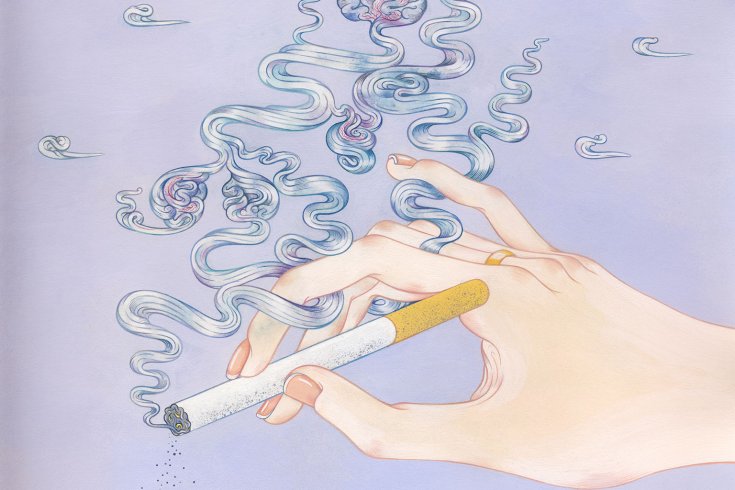Ihad expected an austere, sanatorium-like atmosphere, with staff in crisp lab coats, the walls plastered with rules and bumper sticker–type slogans: Rehab is for quitters, maybe. Instead, the place skews toward homey, or at least as homey as a medical facility can be, with nary a motivational poster to be seen. My room features a Murphy bed, a small desk, a wall-mounted TV, and an inoffensive print; brown and beige are the dominant colours. The space is reminiscent of an upscale dorm or a highway motel, except for the syringe disposal receptacle in the bathroom.
But matters of decor are not top of mind on this Friday in January, as I stand outside the entrance of the building. Instead, I’m focused on cigarettes—or, more precisely, smoking as many of them as possible in the time left before 4:30 p.m., when nine other people and I will hand over our packs and lighters, and put our faith in the Mayo Clinic’s Nicotine Dependence Center.
Ahalf-century ago, I lit up for the first time. It was 1964, the same year that United States surgeon general Luther Terry released a depth-charge report unequivocally drawing a direct link between cigarettes and lung cancer, chronic bronchitis, emphysema, and coronary heart disease. Or, as the New York Times headline succinctly put it, “Cigarettes Peril Health.” Being fourteen at the time, I didn’t read the Times, but the news filtered into my hometown of Guelph, Ontario—the site of an Imperial Tobacco factory, where, it was said, workers got free cartons. My friends and I mordantly joked that every cigarette we smoked would shorten our lives by ten minutes. Because we were immortal, this didn’t seem like a big deal.
At school, I belonged to the science club and entered fairs with projects like “The Miracle of Rayon.” I was an A student in home economics; my pocket money came from babysitting. In short, I was something of a nerd, and desperately wished for an edgier image, which I believed smoking bestowed.
At the time, nearly half of Canadian adults were smokers, and in that Mad Men era you could light up just about anywhere—planes, banks, movie theatres, even doctors’ offices and hospital rooms. To object to someone smoking was rather like being the cranky neighbour yelling at kids for playing hockey in the street. These days, though, the 16 percent of us who still smoke daily are the ones beyond the pale—which is to say a car’s length or two from building entrances, if we’re obeying the omnipresent signs.
I could claim that an extremely belated road-to-Damascus experience led me to rehab, but the fact is, for years now, you have had to be either terminally dense or a Big Tobacco executive (not mutually exclusive categories) to deny the health risks. It wasn’t even the pariah status, the death-ray glares of disapproval that lighting up automatically incurs. True, that contempt—and its flip side, a self-image hovering below zero—was one of the reasons I’d quit numerous times over the past five decades. I had stopped for as little as a week and as long as seven years, the latter an interregnum that went up in flames during an evening that featured a lot of fun and too much wine; suddenly, cadging a cig seemed like a good idea. Within a week, I was back to a pack and a half a day.
This time, there were two things that influenced me to kick the habit. One was my kid, twenty-three years old and a smoker since he was fifteen. I know he’s not immortal, even if he doesn’t, and my guilt about being a noxious role model is intense. The second, at the risk of seeming to have skewed priorities, was the money. I was smoking two large packs a day—fifty cigarettes, about thirty more than what’s currently defined as heavy smoking—which translated to a ludicrous $8,750 a year. On the cusp of retirement, with its decreased income, I realized I couldn’t afford to keep smoking if I still wanted to live indoors.
Cigarettes are expensive, but, as I learned, so is quitting. Knowing that a period of policed abstinence and sharp-eyed supervision would be critical to getting me through the first few days, I started looking for a residential cessation program. I anticipated finding dozens of choices. Seek live-in treatment for drugs or booze, and you can generally be accommodated speedily in a free, non-profit 12-step program. If you can hang on for a while, your stay at a private facility will be covered by most provincial health care plans; with a decent extended health plan, you may not even have to wait.
Nicotine addiction is both more common and more deadly than dependence on alcohol or other drugs, and, according to one study, costs the Canadian economy $17 billion a year. But being strung out on tobacco is treated almost exclusively through outpatient programs and other measures of debatable utility, such as the helpline number tucked into every pack. (I called once, three weeks into an attempt. The woman on the other end of the phone said, essentially, Carry on, and wished me luck.) I discovered that there is just a handful of residential cessation programs in North America. One, located outside Ottawa, I crossed off my list as soon as I encountered the New Agey phrase smudging materials.
So here I am at the Mayo, in unprepossessing Rochester, Minnesota, a city that’s never been on my bucket list. About once a month, the Nicotine Dependence Center takes over the fourth floor of the Colonial Building, on the eastern edge of the clinic’s considerable downtown campus. There’s a simple reason why the program isn’t offered more frequently, and it unites all ten of us would-be quitters: unlike most people, we can afford the $5,500 (US) price tag for the eight days, plus airfare and the cost of the patches, gum, and other nicotine replacements that are central to the clinic’s treatment model. (Nicotine itself, while highly addictive, is not carcinogenic, nor does it cause the myriad other health issues associated with cigarettes.) In my case, the total comes to more than $7,000 (US). Not a pack’s worth of the cost is reimbursed by my provincial health plan or my employee benefits.
The truth is that we don’t fund cigarette rehab because we don’t consider smoking a true addiction. Today, people are said to be hooked on everything from Facebook to Oreos, but being an Internet fanatic or cookie monster is not the same as experiencing the panicky tightening in the gut, the I’d-do-anything-for-a-hit feeling, that strikes when you’re running short of fill-in-the-blank—smack, booze, Oxys, cocaine, cigs. Unlike those other substances, though, cigarettes are both legal and, when used as intended, apt to kill their consumers. It’s impossible to contemplate these dissonant facts without engaging in some conspiracy theorizing. Might there be a connection between cigarettes’ still-lawful status, despite their indisputably lethal nature, and the $7.3 billion in tobacco-related tax revenue the federal and provincial governments reaped last year? After all, if everyone actually quit, that’s a lot of dough forgone.
Behind these counterintuitive policies is the big lie that smoking is merely a bad habit. As the industry’s disingenuous slogan of the 1980s and 1990s had it, “My pleasure, my choice.” But it’s not just Big Tobacco that advances this perspective. Last February, Globe and Mail columnist Margaret Wente articulated a common outlook: “If addiction is a disease, it’s a peculiar one.” Her point was that, unlike those with so-called real diseases, addicts get themselves into trouble and can jolly well get themselves out. “The disease model of addiction implies that the victim is helpless,” she wrote. “It denies the role of personal agency, which is probably the most important force of all when facing down your demons.”
This is reminiscent of how wartime post-traumatic stress disorder was once chalked up to LMF—lack of moral fibre. It’s the attitude of those who unhelpfully recount how they just got up one day and pitched their cigs, the implication being that you could do the same if you weren’t such a gormless loser. And it’s a point of view that even permeates anti-tobacco campaigns, which over the decades have morphed from concern for the addict—“Smoking kills”—to stigma-driven shock and shame. Think of that American Cancer Society poster featuring the ravaged older woman, puffing away, with the slogan, “Smoking is very glamorous.” Cruise the Internet a bit, and you’ll find images that are even more jolting. One substitutes a cigarette filter for a woman’s nipple (i.e., smoking is bad for breastfeeding babies); another, aimed at teenagers, equates smoking with being forced to perform oral sex. In these ads, there is no acknowledgement of cigarettes’ extraordinary addictive power. We don’t expect drug users to just kick the habit, but that idea permeates cigarette discourse. The message is as clear as a No Smoking sign: when it comes to quitting, you’re on your own.
In the minutes before Friday’s 4:30 p.m. relinquishing of our cigs and lighters, everyone chain-smokes furiously outside the Colonial Building. We aren’t acquainted yet, but there’s lots of nervous banter as we mainline our nicotine, huddled in twos and threes. Do any of us really believe the butts we’ve just ground out will be our last? Still, once inside, we all participate in the disposal ritual—everything’s tossed into an ordinary plastic bag, which doesn’t strike me as sufficiently ceremonious—and then we have our initial group therapy session. Besides me, there are six men and three women, two of whom are also Canadian.
A decade ago, I realized I was drinking too much—more than a bottle of wine a night—and tottered off to Alcoholics Anonymous. There, we called them drunkalogs—tales of humiliating things done while under the influence of booze. At the exotic end of the spectrum were exploits like attempting to steal a plane or losing a rental car; more common were heartbreaking accounts of domestic upheaval, workplace flame-outs, sordid affairs. In smokers’ rehab, our versions are more quotidian. Illicit puffs in airport washrooms figure prominently, with a couple of the guys trading stories about their favourite spots at Chicago O’Hare. An entertainment entrepreneur spins a hilarious story about smoking up a hotel room and simply leaving the several-hundred-dollar fine in cash when he checked out. The parents of younger children describe John le Carré–level diversionary tactics to prevent their kids from learning their secret. I recount having missed a plane in Dublin a few years ago because I was indulging my addiction rather than lining up for the security check, a dumb-ass move that cost me $500 in rebooking fees; it’s too painful to confess to the group that I missed the moment of my mother’s death because I’d nipped out for a hit. None of these anecdotes addresses the matter of compromised health, but they don’t really have to, since one of us, a fellow in his late fifties, has barely finished chemo for lung cancer.
The absence of the titillating or outlandish in our stories perhaps explains the dearth of motivational books or movies for the would-be non-smoker. Prior to my trip to the Mayo, a diligent search for butting-out memoirs, something along the lines of Mary Karr’s Lit, or Augusten Burroughs’s Dry, turned up just one. Lighting Up features an overexcited subtitle—How I Stopped Smoking, Drinking, and Everything Else I Loved in Life Except Sex—that fails to suggest the mix of chaos and catharsis that makes a good taking-the-cure account. On the flick front, finding nothing about tobacco at all, I thought I’d screen some of the booze-and-drugs rehab movies I’d watched when I decided to quit drinking—28 Days; Clean and Sober; My Name Is Bill W. What I hadn’t noticed ten years ago was that everyone in these movies smokes all the time. In fact, being a nicotine fiend is kind of a thing among reformed drinkers. Bill Wilson of AA fame apparently smoked like a chimney. Caroline Knapp, the author of the acclaimed memoir Drinking: A Love Story, died of lung cancer at forty-two. As Burroughs observed, “Everybody in recovery smokes.” You can see the problem. Popular culture basically doesn’t acknowledge smoking as a dangerous addiction, nor does it lend it the patina of romantic dissolution that might garner users more sympathy—or better treatment options.
Iused to wonder why I am the only member of my family with addiction issues. Then I realized a strong vein of clinical depression runs through our history, and addiction is often a co-occurring condition. My father struggled through many dark days; one of my sisters committed suicide; my cousins knock back antidepressants, and so do I. I saw my first psychiatrist at eighteen, when even taking a shower began to seem too hard. I can’t recall when my drinking shifted from recreational to alcoholic, but it spiked during a period of high drama: My kid (step-grandson, actually)—who, tragically, has fetal alcohol syndrome—was a rebel without a cause by the time he was thirteen. My husband had his own alcohol issues. There was also my then-undiagnosed bipolar disorder, which co-occurs with alcoholism up to 50 percent of the time. At the Mayo, we don’t spend a lot of time comparing our psychological profiles, but I quickly realize that I’m not alone. Three of the others are addicts-turned-teetotallers; another takes a pharmacopoeia of medications that rivals my own.
Scientists trying to understand people like us have found that the brain of the zebrafish, a freshwater member of the minnow family, is a good substitute for the human organ when it comes to studying addiction. The Center for Tobacco-Free Living, a public-information space at the Mayo, features a big tank labelled Zebrafish, in recognition of their key role in research. But the tank’s occupants are imposters—the real zebrafish were so small they kept getting sucked into the filter. It’s not hard to see a metaphor here, with the doomed creatures representing smokers trapped and enslaved by Big Tobacco. This interpretation, embraced by the Mayo program, is comforting: it’s not my fault.
Still, I have to acknowledge that being a cigarette addict isn’t all tubercular coughing and grimy ashtrays. Smoking doesn’t come with the perils associated with other types of dependence—jail time, homelessness, personal chaos. Plus, there’s that first-puff-of-the-morning kapow, the immediate rush of nicotine to the brain, a high that doesn’t fade no matter how long you’ve smoked—no chasing the dragon, trying to recapture the sensation of your initial hit. It makes for great anecdotes, like the time I realized the only other occupant of a New York theatre’s gritty little smoking area (except for a bodyguard) was Pierre Trudeau, then on his second stint as prime minister. And then there’s the camaraderie of smokers at events, puffing away alfresco and joking that we are the most interesting people there. (Or were. Recently, experiences like this past New Year’s Eve have been more typical: inside, the other guests were playing a boisterous game of Rob Ford charades—hammered on the Danforth; I have more than enough to eat at home—while I shivered alone on the porch with my Rothmans Special.)
But these golden moments account for just a fraction of the half-million-odd cigarettes I’ve consumed in my life. According to Dr. Richard Hurt, the founder of the Mayo program, I’ve mostly lit up because the numerous nicotine receptors in my brain have been calling out for another hit. Why some people can smoke and not get hooked is what those zebrafish are helping to illuminate. Clearly, I’m not addiction-proof, and neither are the members of my Mayo posse.
In our discussions throughout the week, there is a major hitch—the word cigarette comes up constantly, just as we’re all trying to bat away the constant fantasy of lighting up. Still, between Friday afternoon and the end of Sunday, the chance that anyone could sneak away for a fix is about zero, since the only way off the ward is in the company of a staff member. We call it lockdown, although there’s no bolted door or elevator code, just a lot of eyes; each night, an unnaturally alert person occupies a desk with a view of all the room doors, just in case. Sunday afternoon finds all ten of us trooping through the maze of tunnels that anchors downtown Rochester, shepherded by our wellness coach and making self-conscious jokes about holding on to the rope. There’s an unspoken acknowledgement that, for many of us, this is not our first time in such a situation, whether because of previous rehab stints or in-patient treatment for mental-health troubles. In a movie, some of us might be sullen or transgressive; in real life, we’re just happy to get a decent cup of coffee in town.
By Monday, we’re allowed out in pairs, and on Wednesday we can go solo. This presents limited risk, since—thanks to the clinic—the entire downtown seems to be a non-smoking zone. Other than the escalating freedom, the days are largely the same, starting with a 6:30 a.m. reveille, followed by breakfast and morning check-in visits from Dr. Hurt. From 9 a.m. to 5 p.m. there are classes and lectures: stress reduction, relapse prevention, nutrition, wellness, group therapy. Everyone fixedly chews nicotine gum or puffs inhalers. One woman cries, but it’s because she gets the news that a beloved pet has died.
In fact, the most dramatic day is the last. Not because of the sadness of saying goodbye—we liked one another fine, but everyone’s been too busy not smoking to be particularly social. Instead, on the final day, we almost can’t get home. A nasty storm causes airline delays and cancellations across a swath of the eastern US. It’s a cosmic test that, a week before, would have seen us all puffing away determinedly. Instead, we take over a group-therapy room, pull out our computers and phones, and attempt to get away from the spot where, a few days earlier, we were wishing aloud we could stay at forever. Some scramble for the Twin Cities to catch alternate flights; I make it as far as Chicago. For the first time in many years, I don’t end up chain-smoking outside the terminal.
The next day, we all check in by email. Everyone made it home, and no one smoked.
In 1992, my husband was diagnosed with lung cancer. He lost one-third of his left lung, but was spectacularly lucky, and is still alive today. Not surprisingly, he quit smoking, and so did I—for a while. But even his near miss wasn’t enough to cure me.
Recently, I tried to determine the odds of a heavy smoker like me getting lung cancer. One source says the chance of dying from the disease is 18.5 percent for women who smoke twenty-five or more cigarettes a day; another that a female smoker has a 13 percent chance of succumbing to it. Lung Cancer Canada’s news is more dire: “For long-time smokers, the chance of dying from a smoking-related cause is, on average, 1 in 2.”
I haven’t yet developed cancer, but a test in rehab revealed that I have early-stage chronic obstructive pulmonary disease, which encompasses both emphysema and bronchitis. The Canadian Lung Association website explains dispassionately that “COPD makes airways swollen and partly blocked by mucus. It also damages…the tiny air sacs at the tips of your airways. This makes it hard to move air in and out of your lungs.” Those people you see lugging around oxygen tanks? Odds are they have COPD. The unequivocal message from the doctor was that if I kept smoking, I would eventually have my own oxygen tank, which would accompany me until my deeply unpleasant death.
Perversely, I’m happy about this news—it is another compelling reason to stay off cigarettes, and there are moments when I need to marshal every one of them. One such time comes four months after my Mayo sojourn. Up until that point, it seemed that the urge—the need—to smoke had been successfully eradicated. Then an administrative foul-up leads to a three-week wait for a vital piece of ID for my kid; without it, he can’t get a new passport, and hence can’t accompany me on a planned trip to Paris. While definitely a First-World problem, it’s the kind of situation that would normally have me chain-smoking obsessively. The image of the oxygen tank keeps me, if only just, from snatching a cigarette out of a stranger’s mouth. Eventually, the crisis passes.
Well, sort of. By the time I land at Charles de Gaulle, I have started drinking again, for the first time in ten years—half a glass of Chardonnay in the airport lounge, a mini-bottle of Merlot on the plane. And today, although I’m not consuming anything close to the quantity of wine I once did, I haven’t stopped. Initially, I thought that I might have grown out of my unwholesome attraction to alcohol—that I can have a casual drink now and then, without returning to full-blown alcoholism. This is, of course, a delusion. Maybe I am simply incapable of quitting more than one vice at a time.
That bout of investigating lung cancer data turned up one more bit of relevant info. Remember how my teenage pals and I joked about each cigarette reducing our lives by ten minutes? Turns out we may have been right—except we underestimated the toll. In a 2000 BMJ paper, researchers calculated that each cigarette could knock eleven minutes off a smoker’s lifespan.
I have smoked away a decade of my life.
This appeared in the November 2014 issue.





